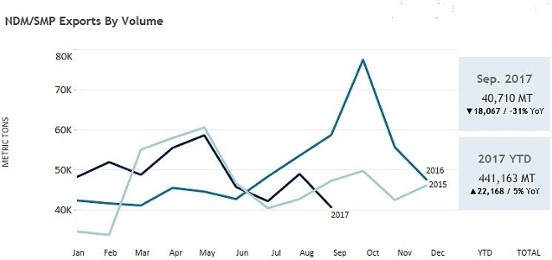Weak sales of nonfat dry milk/skim milk powder (NDM/SMP), particularly to Southeast Asia, depressed overall U.S. export totals in the third quarter. U.S. suppliers shipped 460,204 tons of milk powder, cheese, butterfat, whey and lactose during the July-September period, down 2% from last year. U.S. exports were valued at $1.3 billion in Q3, up 9%.
Exports of NDM/SMP in Q3 were 131,988 tons, down 18% vs. a year ago. Sales to Southeast Asia were just 34,536 tons, a 35% decline, with significant lost volume to Indonesia (-60%) and Vietnam (-76%). Shipments to Mexico also were lower, falling 19% short of last year’s pace.
(Official USDA data continues to show an increase in WMP exports to Mexico. However, Mexican import data and trade sources don’t corroborate this, and we believe this volume represents SMP sales that were misclassified at the port. Therefore, we’ve adjusted NDM/SMP and WMP trade data for June 2016 to September 2017 to account for this misclassification.)
With declining powder exports, U.S. inventories of NDM increased in Q3 for the first time since 2008. At the end of September, stocks were a record-high 146,000 tons, nearly 50% more than last year. Lagging U.S. exports reflect strong competition from European suppliers, as well as a slowdown in global buying activity. Oversupply in the world market has led SMP prices to fall to their lowest level since spring 2016.

Southeast Asian countries also took less U.S. whey in Q3. Exports were 22,072 tons, down 11%. Sales of whey protein concentrate (WPC) and modified whey were off 23%. Meanwhile, lactose shipments to the region were down 26%.
Overall U.S. exports to Southeast Asia in September alone were just $40 million (-29%), the worst month since February 2010.
Click here to see more...